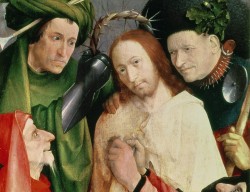
Wuyts 1968
“Beschouwingen bij een Doornenkroning toegeschreven aan Bosch” (Leo Wuyts) 1968
[in: Jaarboek Koninklijk Museum voor Schone Kunsten Antwerpen, 1968, pp. 35-66]
[Also mentioned in Gibson 1983: 77 (E30)]
Wuyts spends some thoughts on the Christ Crowned With Thorns in the London National Gallery, which is attributed to Bosch. After a brief survey of the iconographical tradition of the Christ Crowned With Thorns theme and of the (three) examples of this theme in the work of Bosch, Wuyts suggests that the London panel does nót represent this theme, because of numerous anomalies. It does not represent The Delivery of Christ to His Executioners either.
In the catalogue of the 1967 Bosch Exhibition two new interpretations were suggested. According to one of them Bosch’s initial purport was to depict a Mocking of Christ, but during the process of painting he changed the composition into a depiction of Christ who is prepared to undergo His suffering. The other interpretation suggested that the painting does not depict a particular episode of the Passion, but rather a confrontation of Christ with the typical heads of two executioners and two pharisees. The crown of thorns would then be a symbol for the complete Passion and the four figures next to Christ would represent the four temperaments and symbolize complete humanity of all times. Wuyts rejects both these interpretations.
According to him the painting is a sheer confrontation of Christ with his executioners, with a focus on pictural games and oppositions. It is remarkable that the painting shows some formal peculiarities and imperfections (the change in direction of Christ’s arms, His mantle, the glove and the right arm of the top left executioner, the headgears of three of the executioners). It is suggested that the London panel should no longer be called an authentic Bosch painting. It rather is the work of an anonymous artist who delivered a piece in Bosch’s style. This would explain the technical and formal flaws that can hardly be accepted from Bosch. It also explains the references to Bosch’s Christ Crowned With Thorns in the Escorial and to other Bosch paintings: these referential details are supposed to present the painting as an authentic work of Bosch…
[explicit]